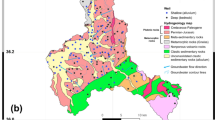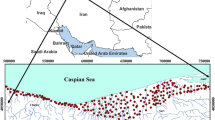Abstract
Groundwater is among the most important water resources around the globe. However, their contaminations are more difficult, costly, and time-consuming to detect and control than those of surface waters. Therefore, the preparation and deployment of vulnerability maps can help monitor and prevent contamination. In this study, the risk assessment of groundwater nitrate contamination was performed. For this purpose, nitrate concentration data in 130 wells in the Mashhad Plain were used to prepare the contamination mapping. Four machine learning models were used to assess the probability of groundwater contamination, including generalized linear model (GLM), boosted regression trees (BRT), and support vector machine (SVM). The validity of each model was assessed by the AUC characteristic curve. To mix the models, a minimum threshold of 80% was assumed. The results showed that the accuracy of the four models ranged from 80 to 90%, so all models were considered in the combination section. Considering the risk map of groundwater contamination due to vulnerability, contamination, and probability mapping, the western and southwestern areas of the aquifer are at high and very high risks of being exposed to nitrate contamination, which is consistent with the land use map of agricultural and urban areas. According to the results, the ensemble method can provide good efficiency.








Similar content being viewed by others
References
Abdullah T, Ali S, Al-Ansari N, Knutsson S (2018) Assessment of groundwater vulnerability to pollution using VLDA and COP models in Halabja Saidsadiq Iraq. J Civ Eng Architect 12(11):798–809
Ahmadi J, Akhondi L, Abbasi H, Khashei-Siuki A, Alimadadi M (2013) Determination of aquifer vulnerability using DRASTIC model and a single parameter sensitivity analysis and acts and omissions case study: Salafchegan-Neyzar Plai. J Water Soil Conserv 20(3):1–25 (In Persian)
Aller L, Bennett T, Lehr JH, Petty RJ, Hackett G (1987) DRASTIC: A standardized system for evaluating ground water pollution potential Using Hydrogeologic Settings, EPA 600/2-87-035. Ada, Oklahoma: U.S. Environmental Protection Agency
Arezoomand Omidi Langrudi M, Khashei Siuki A, Javadi S, Hashemi SR (2016) Evaluation of vulnerability of aquifers by improved fuzzy drastic method: case study: Aastane Kochesfahan plain in Iran. Ain Shams Engineering Journal 7(1):11–20
Asefi M, Radmanesh F, Zarei H (2014) Optimization of DRASTIC model for vulnerability assessment of groundwater resources using analytical hierarchy process (case study: Andimeshk Plain). Irrigation Sciences and Engineering 37(1):55–67 (In Persian)
Brown CE (1998) Multiple discriminant analysis. In: Applied multivariate statistics in geohydrology and related sciences. Springer, Berlin, Heidelberg
Fijani E, Nadiri AA, Asghari Moghaddam A, Tsai FTC, Dixon B (2013) Optimization of DRASTIC method by supervised committee machine artificial intelligence to assess groundwater vulnerability for Maragheh– Bonab plain aquifer, Iran. J Hydrol 503:89–100
Gemitzi A, Petalas C, Tsihrintzis V, Pisinaras V (2006) Assessment of groundwater vulnerability to pollution: a combination of GIS, fuzzy logic and decision making techniques. Environ Geol 49(5):653–673
Godebo TR, Merola BR, Kravchenko J, Vengosh A, Mccornick P (2011) Groundwater geochemistry, quality and its impact on human health: field based dental fluorosis assessment in the Main Ethiopian Rift. 4th International Conference on Medical Geology-Italy
Gogu RC, Dassargues A (2000) Current trends and future challenges in groundwater vulnerability assessment using overlay and index methods. Environ Geol 39:549–559
Golkarian A, Naghibi SA, Kalantar B, Pradhan B (2018) Groundwater potential mapping using C5.0, random forest, and multivariate adaptive regression spline models in GIS. Environ Monit Assess 190(3):149
Haycock N (1990) Handling excess nitrates. Nature 348:291
Jhariya DC, Kumar T, Pandey HK, Kumar S, Kumar D, Gautam AK, Baghel VS, Kishore N (2019) Assessment of groundwater vulnerability to pollution by modified DRASTIC model and analytic hierarchy process. Environ Earth Sci 78:610
Kapelj S, Loborec J, Kapelj J (2013) Assessment of aquifer intrinsic vulnerability by the SINTACS method. Geologia Croatica 66(2):119–128
Khashei Siuki A, Shahidi A, Amirabadizadeh A, Mjafarzadeh A (2018) Performance assessment of ann and svr for downscaling of daily rainfall in dry regions. Iran J Soil Water Res 49(4):781–793
Loveless SE, Lewis MA, Bloomfield JP, Stuart ME, Ward R, Davey I, Hart A A. (2019) Method for screening groundwater vulnerability from subsurface hydrocarbon extraction practices. J Env Management, 249
Matzeu A, Secci R, Uras G (2017) Methodological approach to assessment of groundwater contamination risk in an agricultural area. Agric Water Manag 184:46–58
Monserud RA, Leemans R (1992) Comparing global vegetation maps with the Kappa statistic. Ecol Model 62(4):275–293
Nerantzis K, Konstantinos S, Voudouris (2015) Groundwater vulnerability and pollution risk assessment of porous aquifers to nitrate: modifying the drastic method using quantitative parameters. J Hydrol 525:13–25
Neshat A, Pradhan B (2015) An integrated DRASTIC model using frequency ratio and two new hybrid methods for groundwater vulnerability assessment. Nat Hazards 76:543–563
Neshat A, Pradhan B, Pirasteh S, Shafri HZM (2014) Estimating groundwater vulnerability to pollution using a modified DRASTIC model in the Kerman agricultural area. Iran Environ Earth Sci 71(7):3119–3131
Neshat A, Pradhan B, Javadi S (2015) Risk assessment of groundwater pollution using Monte Carlo approach in an agricultural region: an example from Kerman Plain, Iran. Comput Environ Urban Syst 50:66–73
Nistor MM (2019) Vulnerability of groundwater resources under climate change in the Pannonian basin. Geo-Spatial Information Science 22(4):345–358
Oroji B (2019) Groundwater vulnerability assessment with using GIS in Hamadan–Bahar plain, Iran. Appl Water Sci 9:196
Rahman A (2008) A GIS based DRASTIC model for assessing groundwater vulnerability in shallow aquifer in Aligarh, India. Appl Geogr 28(1):32–53
Rahmati O, Melesse AM (2016) Application of Dempster–Shafer theory, spatial analysis and remote sensing for groundwater potentiality and nitrate pollution analysis in the semi-arid region of Khuzestan, Iran. Sci Total Environ 568:1110–1123
Sajedi-Hosseini F, Malekian A, Choubin B, Rahmati O, Cipullo S, Coulon F, Pradhan B (2018) A novel machine learning-based approach for the risk assessment of nitrate groundwater contamination. Sci Total Environ 644:954–962
Sener E, Davraz A (2013) Assessment of groundwater vulnerability based on a modified DRASTIC model, GIS and an analytic hierarchy process (AHP) method: the case of Egirdir Lake Basin (Isparta, Turkey). Hydrogeol J 21(3):701–714
Sheykhi Narany T, Ramli MF, Aris AZ, Sulaiman WNA, Fakharian K (2014) Assessment of the potential contamination risk of nitrate in groundwater using indicator kriging (in Amol–Babol Plain, Iran). From Sources to Solution. Springer, Singapore: 273–277
Shrestha S, Semkuyu DJ, Pandey VP (2016) Assessment of groundwater vulnerability and risk to pollution in Kathmandu Valley, Nepal. Sci Total Environ 556:23–35
Stigter TY, Ribeiro L, Carvalho Dill AMM (2006) Evaluation of an intrinsic and a specific vulnerability assessment method in comparison with groundwater salinisation and nitrate contamination levels in two agricultural regions in the south of Portugal. Hydrogeol J 14:79–99
Van Beynen PE, Niedzielski MA, Bialkowska-Jelinska E, Alsharif K, Matusick J (2012) Comparative study of specific groundwater vulnerability of a karst aquifer in central Florida. Appl Geogr 32:868–877
Vias JM, Andreo B, Perles MJ, Carrasco F (2005) A comparative study of four schemes for groundwater vulnerability mapping in a diffuse flow carbonate aquifer under Mediterranean climatic conditions. J Environ Geol 47(4):586–595
Xie C, Luo C, Yu X (2011) Financial distress prediction based on SVM and MDA methods: the case of Chinese listed companies. Qual Quant 45(3):671–686
Author information
Authors and Affiliations
Corresponding author
Additional information
Responsible Editor: Amjad Kallel
Rights and permissions
About this article
Cite this article
Rokhshad, A.M., Khashei Siuki, A. & Yaghoobzadeh, M. Evaluation of a machine-based learning method to estimate the rate of nitrate penetration and groundwater contamination. Arab J Geosci 14, 40 (2021). https://doi.org/10.1007/s12517-020-06257-y
Received:
Accepted:
Published:
DOI: https://doi.org/10.1007/s12517-020-06257-y




